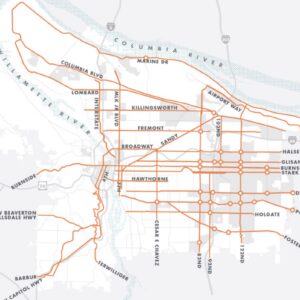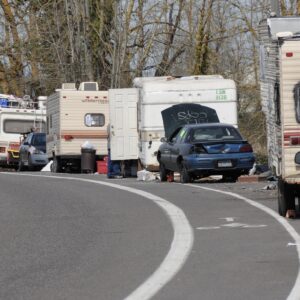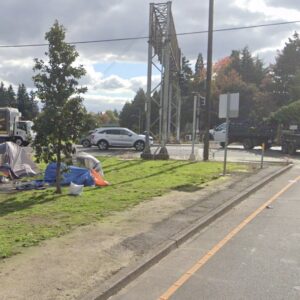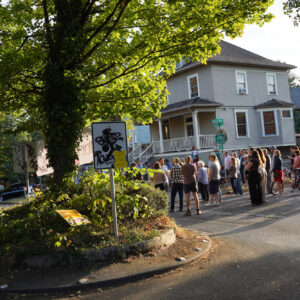According to a new report from Multnomah County, traffic-related fatalities made up the second largest number of unintentional deaths among homeless residents in our area. At least 315 people died while homeless in 2022, a record high since the data was first collected in 2011. Among those, 14 people died as a result of traffic collisions — the second highest number among all categories of unintentional deaths.
These stats come from Multnomah County’s Domicile Unknown report released in collaboration with nonprofit advocacy group Street Roots on Wednesday.
In 2020 and 2021, a separate Multnomah County report found that people experiencing homelessness accounted for 24% of all traffic deaths. The problem hit a peak in 2021 when 19 of the 27 pedestrian fatalities in Portland befell people who lived outside. This trend mirrors national numbers that show an increase in pedestrian fatalities among homeless people every year for the past five years.

while walking on Highway 99 East, near Milepost
20 in Canby

hit-and-run driver on the 4600 block of S.E.
Powell Boulevard late on April 4, 2022.

by the driver of an SUV while walking on the
Morrison Bridge near the Interstate 5 ramp.
“The issue may seem complex, but at the core, it’s quite simple: speed, impairment and distraction contribute to over 90% of vehicle crashes in the U.S… This public health epidemic is preventable but only with timely attention and action from the government at every level,” said The Street Trust Executive Director Sarah Iannarone in a county statement.
The problem has gotten so bad that the Joint Office of Homeless Services, a collab between Multnomah County and the City of Portland, has begun handing out reflective gear as part of outreach services. “We’ve got to make sure people are safer and more visible when they’re getting from here to there… especially at night when most of these fatalities occur,” said County Chair Jessica Vega Pederson.
The new report features stories of some of the people who died on our streets. 54-year-old John Ellstrom died when he was struck by the driver of an SUV while walking on the Morrison Bridge near the Interstate 5 ramp on Mother’s Day. And 47-year-old Angela Boyd was killed by a hit-and-run driver as she crossed SE Powell Boulevard on April 4th. The driver of the late-model Subaru that hit her is still on the loose.
While our entire population faces the prospect of increasing traffic fatalities, people experiencing homelessness are at much higher risk. The report found that they are 45 times more likely to die of a transportation-related death than the overall population — a greater disparity than any other cause including drug overdoses and homicide.
One reason for this disproportionate impact is that many encampments are adjacent to high-speed roads. Early last year, Portland Mayor Ted Wheeler tried to combat this situation by ordering a ban on camping next to roads listed on the city’s high crash network.
But bans and the sweeps that accompany them, are not a proven remedy. A group of Portland State University students researching the issue found that forcing people to relocate to areas with safer traffic patters often just results in them having to travel further to reach services and destinations — thus exposing them to more car traffic dangers in the process. To get at the root cause of the problem, they recommend building safer streets and improving the quality and accessibility of shelters.
— Read the 2022 Domicile Unknown report here.







Thanks for reading.
BikePortland has served this community with independent community journalism since 2005. We rely on subscriptions from readers like you to survive. Your financial support is vital in keeping this valuable resource alive and well.
Please subscribe today to strengthen and expand our work.
I’m sure these numbers will go up even further when the sanctioned camping area adjacent to Portland Rd. opens. Giving out reflective gear is a nice gesture but, until the city and state commit to keeping the encampments away from freeways, on/off ramps, and other high traffic roads, this is going to continue to be a problem.
Reflective gear isn’t a nice gesture. It’s an abdication of our responsibility to allow vulnerable people to live in such dangerous locales (often in squalid conditions). It’s time to offer shelter and enforce a camping ban. Allowing and enabling street camping is NOT compassionate, it’s promoting inhumane conditions and putting people at risk of being killed.
I don’t think anyone’s thinking of it as a solution. It’s something that can be done now to keep people safer until they’re off the street.
I don’t think anyone is thinking, “I was on the verge of trying to get into a shelter, then I got this free reflective cap so I changed my mind”.
“Portland’s Joint Office of Homeless Services now passes out reflective gear as part of homelessness outreach.”
Is there more information on the materials being offered?
I’d reach out, it’s a new department IIRC and they probably don’t have a lot of capacity for anything other than personal comms right now.
I read the linked article but it still seems unclear if this count is of pedestrians who were hit, or does this also account for drivers in vehicle crashes?
There are too many cars on the roads, and we need to remove all the unregistered and uninsured ones first. I see a lot of those near camps and lived in/driven by homeless people. A basic safety inspection would be another great thing to implement. Many states have these and they really do help make the road a safer place. I’m amazed at how many vehicles I see around Portland with a brake light out, and lately I’ve seen a few with BOTH out, and just the 3rd brake light working.
Not to be pedantic, but the 44.8% should be 4,480% since they are 45x more likely…
Yeah I was very confused about this.
PS, I fixed the text, thank you.
Thank you!
That is a horrifying number.
The 44.8% figure actually appeared in the introduction of the report, then in the body it says 45 times as likely. That’s a shocking number and it shows how vulnerable people are.
We know pretty well how many people died because they aren’t going anywhere and there’s time to figure out if they are in a listed category. The criteria seem reasonable.
The population base for the estimate is harder:
“Although the exact number of PEH is unknown, the best estimate we have is based on data from the 2022 Point in Time Count Report. The 2022 report found that 5,228 people were counted as experiencing homelessness.” The most thorough count done in the dead of winter may not tell us how many are unhoused throughout the year.
Whatever the differential is, it’s still a shocking figure and I don’t minimize that. I do think that we need other ways to estimate the number of people unhoused. One method might be to interview a random sample and ask them how many people they know are unhoused. It’s not a direct count but maybe it’s a way to put an upper bound on the population. You can’t serve or budget for people who don’t officially exist.
This is important to me because I’m human. My neighborhood doesn’t have sidewalks, my main transport is a bike, and I’m rarely in a car so I see this thing from a similar direction. It is true a lot of my hours are inside a house and I don’t have the stress or exposure of a person camping.
Hi X,
Thanks for the conversation!
I went with the “Mortality Risk” bar chart comparison of risk between the housed and unhoused populations. They mention how they did the population calculations to come up with the risk. I don’t see a 44.8% figure anywhere.
The chart showed 45 to one. A lot of people mess up percentages. I think it’s best to stick with expressing it as 45 to one.
Great to see that “compassion” at work.
I think the term that Gonzalez prefers is “Tough Love.”
Nice to see you are happy with these outcomes, it would be awful for Gonzalez to do something about it.
[Ed: deleted last sentence]
That’s exactly what needs to happen.
“To get at the root cause of the problem, they recommend building safer streets and improving the quality and accessibility of shelters.”
I’m all for this… but it seems like the *quantity* of shelter beds/rooms is also a huge factor. No matter how high the quality of any given shelter bed or room, if it’s already occupied, it’s useless to a person on the street.
Heck, a low quality room in a crappy building would be better than a tent on the side of I-205, right?
Not necessarily. “Crappy” can mean physically dangerous (exposure to mold, etc. but also not secure from violence, etc.). With restrictions on who can access specific “shelter” spaces — can a couple be together, or will they be forced to separate? can I bring all my stuff with me? what about a service animal or pet? — and on when they can be accessed — do I get tossed out each morning? can I be assured I’ll have the same space to return to later in the day — there are many reasons people opt for living outside. That does not mean they do not deserve safe, indoor shelter, with access to running water and means to store and cook food. It means that we cannot pretend that forcing people into “a low quality room in a crappy building” is actually protecting them. This approach also ignores the fact that our current streets/roads and current driving practices are inherently dangerous. Fixing those problems will make all of us safer, particularly groups who are disproportionately harmed by the current dangers (people without stable housing, but also other elderly people, people in particular neighborhoods, communities of color, etc.). So to summarize: REAL fixes to the lack of affordable housing, and REAL fixes to dangers streets/roads/driving, means we will all be better off!
REAL fixes you are talking about are years away
Thats hundreds of deaths in the meantime.
Apparently an imperfect housing is worse than death.
OK.
Many people living on the street reject offers for housing. It could be the “Cadillac” of shelters but people would still say no because it doesn’t offer the autonomy and total lack of regulation that comes with the Portland flavor of being homeless… which really is more of a vagabond lifestyle that has been adopted and perfected.
People wonder why the solutions don’t seem to be working, and it’s because both sides are gaslighting one another.
Camps make a street a residence district. PBOT has ignored calls to post and operate these streets at 20 MPH.
Here’s the BikePortland post from 2021 about a pedestrian death on 33rd Drive. It references Kocher’s attempt to raise the issue of road safety near areas where people are camping:
https://bikeportland.org/2021/07/07/followup-ne-33rd-drive-pedestrian-death-334638
Distracted drivers, fentanyl users, poor lighting…. Lack of housing… the list goes on.
We will NEVER as local taxpayers be able to provide free housing for everyone who is homeless. It’s time to disabuse ourselves of this notion. We can and should get people into safe, dry shelter. Shelter is a right, housing needs to be earned.
I work in the non-profit word. Have you been to a shelter? You’ll get a good idea as to why people may order being outside.
Reflecitve gear?
This is more absurdity akin to passing out fentanyl smoking supplies to drug addicts. It’s time to offer shelter and get people OFF the cruel and dangerous streets. It’s time to enforce no camping laws, enabling people to live on the streets with impotent half measure like reflective gear is nothing more than an ineffective Band-Aid.
Correction: “ The report found they die at a rate 44.8% higher than the overall population”
No, it was 44,800% higher, that is 44.8 times higher.
With a rate that much higher, one has to wonder if it is the behavior of the individuals being killed because I have a hard time reconciling that the drivers hitting them are 44.8x worse drivers than the average.
If I were to say people without life-preservers are 44.8x more likely to drown in the event of a boat accident, nobody would be discussing the boat’s safety features.
If only the county had a bunch of funding to do something about it.
Remember that Bike Loud, the Street Trust and the author of this blog all opposed removing camps from high-crash corridor streets.
And then this article, which is basically “Golly! If only people rode bikes more!”
I’m just tired of the disingenuous reasoning, the whataboutism and group-think.
These people can’t take care of themselves, and you’re all using them as a pawn to further your own goals. I don’t think you actually care about them very much at all. Quite typical.
Rousting camps does not magically make people disappear. They still live here, they’re still in our region because often they have family, friends, medical providers and jobs here. Taking away some of a person’s belongings does not give them better choices and it’s just a question of which roadside or waste ground they will camp on next.
A lot of people on the street are already working to right themselves. Instead of harassing them we should make it easier for them to wash, to use a bathroom, to get mail and phone service, to move around, and yes get drug treatment if they’re ready for that, without being judged or arrested. Any of those things would reduce the number of people camping on the street. They’d also reduce the number of people in emergency rooms, in jails, and dead on the road.
Why should a taxpayer care? They should care because all those outcomes are the most expensive way possible to ‘address’ a person camping by the road. We, you, are paying that cost right now.
Is it permissible to make any rules at all about where camping is simply too dangerous or disruptive to be allowed?
Those rules exist I think. It’s damned hard to enforce them. That’s why ODOT and other agencies are piling up rocks. It’s apparently easier than any other interaction.
Removing people from dangerous areas works. Do it again and again if you have to, until people get the message that camping in a freeway island is not acceptable.
Other cities don’t have this problem, only the ones who decided not to enforce common sense rules. And frankly I would love to see my tax dollars spent like that. Fewer deaths, less trauma inflicted unnecessarily on the public who has to witness these tragedies.
No more excuses from the activist class.
Comment of the week! But it will never be chosen as bike “activists” in Portland never want to look at themselves as part of the problem.
In much the same way people of color are used.
I see the article uncritically quotes the Street Trust “The issue may seem complex, but at the core, it’s quite simple: speed, impairment and distraction”.
How, I wondered, did those speedy impaired distracted drivers manage to pick out homeless people from all the other pedestrians and home in on them, guided missile-like? It seems that feat would actually require keen and alert drivers?
Perhaps it might, just might, instead be something about the impairment and distraction of homeless persons when walking on streets, freeways, etc? But I saw nothing in the article hinting at that possibility. So yes, let’s continue gaslighting ourselves.
Take this morning. A homeless person crossed Sandy against the light, shuffling right into traffic, not looking, not taking any precautions. It was light, and the vehicles that he shuffled out in front of had drivers who saw him, braked, and stopped, so he was unharmed. At night, the outcome might have been different.
Most of us have seen this behavior many times. Whether impaired by drugs, mentally ill, or simply numb from cold and wet and misery, it is common to see homeless persons walking and standing in the roadway in ways that most people would consider reckless or suicidal.
A particular group is killed in car-pedestrian accidents 45X more than the average. That same group is also many-fold more likely to cross or walk in roadways at night in the most dangerous manner. Might there be a connection? That escapes the experts in political correctness?